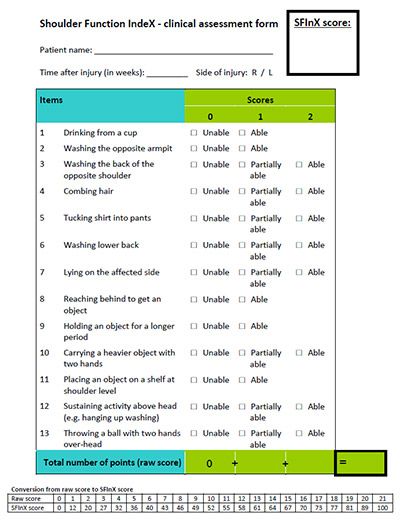The SFInX has been developed to be used as a clinical tool for functional measurement of the shoulder. In other words, the ability to perform activities with the affected arm is evaluated. To do this, a few items of equipment, a simple strategy for testing and the clinical assessment form are required.
Equipment for SFInX testing
- Cup or small water bottle
- 1.5kg object
- 3kg object in a (shopping) bag
- 6kg object
- Ball
- Chair with no armrests
- Bed (or plinth) and pillow
- Shelving at shoulder height and above head
Check the SFInX User Manual for equipment recommendations.
Strategy for SFInX testing
The order of the SFInX items on the clinical assessment form has been designed so that clinical testing is made easy and quick, and so that items with no or little equipment are performed first. With some familiarity of the SFInX, the testing of all 13 items in this order can be performed in 5-7 minutes. The order is not strict and can be modified to your own preference.
Preparation
Choose a room with or close to shelving at several heights (shoulder and above head). Place a chair without armrests facing a table or plinth. Have a 1.5kg object, a bag with 3kg contents, a 6kg object and a ball on the floor at the bed’s foot end. And, place a cup on the table or plinth to start testing item 1.
Testing
Starting in sitting at a table or facing the plinth, items 1 to 4 can be performed with only a cup required as equipment.
Items 5 and 6 will be performed in standing without equipment, followed by item 7 lying on the affected side on the bed.
Turning the chair around so that the backrest is positioned close to the bed or a table, item 8 will be performed in sitting with a small 1.5kg object.
The remaining items 9 to 13 will be performed in standing with equipment, respectively: a bag with 3kg contents, a 6kg object, a 1.5kg object and shelf at shoulder height and above head, and a ball.
Clinical assessment form
Download the clinical assessment form or the complete SFInX User Manual.

